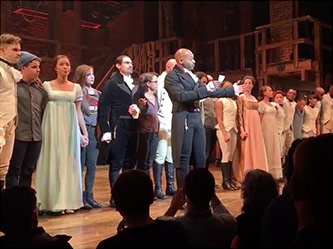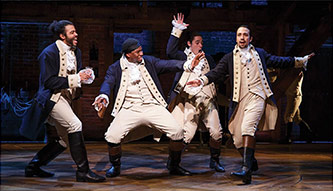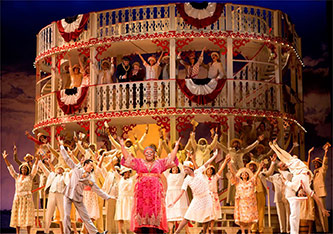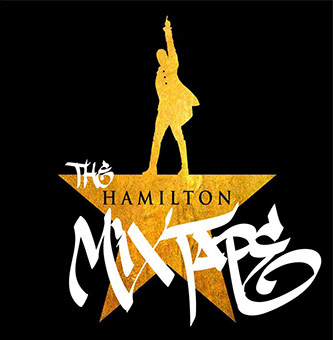American Music Review
Vol. XLVI, Issue 1, Fall 2016
By Philip Kasinitz, Graduate Center, CUNY
Of all the bizarre news stories to permeate social and mainstream media in the days following the election of Donald Trump, few were as surreal as the “Twitter war” surrounding the controversy between the incoming president and the cast of the Broadway musical Hamilton. The dispute started on the evening of 18 November when Vice President elect Mike Pence attended the hit show with his children. Knowing Mr. Pence would be in the audience, the creator of Hamilton and original star, Lin-Manuel Miranda, wrote a short address to him on behalf of “diverse America” expressing fears about the Trump administration.
The address was delivered during the curtain call by one of the show’s stars, Brandon Victor Dixon, who portrays Pence’s ill-fated predecessor Vice President Aaron Burr. Pence, who had been booed upon entering the theater, left while the address was being given although he later insisted he had not walked out in protest and had listened to the short speech in the lobby (leaving during the curtain call to avoid crowds is common practice for celebrities and secret service protectees). Pence never responded directly to the concerns raised and, perhaps unwilling to get into a debate with a fictional character, diplomatically insisted that he had not been offended by the remarks and that he had enjoyed the show and its “talented” cast.
Pence’s boss showed no such restraint. Within hours he had unleashed one of his famous Twitter rants, accusing the show’s cast and audience of “lecturing” and “harassing” the future Vice President, demanding an apology and describing the most popular Broadway show in years, which he had never seen, as “over rated.” Soon there were more tweets and counter tweets which ate up the better part of a news cycle and took a fairly parochial New York dispute national, which was probably not unwelcome as Hamilton was about to open in Chicago and with productions planned for several other cities. There was even a call to boycott the New York production, although it was already sold out for more than year in advance.
That a popular Broadway musical, one celebrating an American historical figure usually seen as a conservative champion of finance capital should become a symbolic flashpoint in America’s ongoing culture wars is remarkable, yet not unpredicted. More than a year earlier, shortly after the show’s Broadway opening, New York Times cultural critic Wesley Morris described Trump as “the presidential candidate for anyone freaked out by the idea of a show like ‘Hamilton.’”1 And while Miranda’s claim to speak for a vaguely defined constituency known as “the diverse America” was perhaps uncharacteristically inelegant, I know what he meant. Part of Donald Trump’s appeal is the unease many Americans, particularly older white rural and suburban Americans, feel about the nation’s demographic transformation. Hamilton is among the most powerful and influential artistic expressions of that transformation that young, multi-racial, urban America has produced to date. The fact that it concerns the most American of stories—the founding of the Republic—and that it puts forward a hip hop reimagining of the most American of themes—who we are as a nation—makes the confrontation with the new President seem oddly appropriate.
Hamilton is the largely hip hop-based retelling of the tragic story of Alexander Hamilton and his long rivalry with Burr, which culminated in the Weehawken New Jersey duel in which the Vice President killed the former Treasury Secretary (as the fictional Hamilton tells his son in the play: “Everything is legal in New Jersey”). Miranda, its creator, composer, lyricist, and original star, is hardly new to musical theater. His earlier Broadway hit In the Heights, a show that blended hip hop and Latin music with more conventional Broadway fare, won him the Tony award for best musical at age twenty-eight—a remarkable accomplishment in an increasingly geriatric genre. Yet while In the Heights was a hit, Hamilton’s impact on the New York theater scene has been nothing short of revolutionary. When it debuted at the Joseph Papp Public Theater in January 2015, word spread so quickly that the run was sold out before the reviews went to press. The following July, a revised and restaged version moved to the larger Richard Rodgers Theatre, where even at Broadway’s exorbitant ticket prices it quickly sold out. The score was soon released as an album and in striking reverse crossover broke out of the tiny Musical Theater ghetto to reach the top of the hip hop charts. It dominated the Tony awards with a record sixteen nominations. Yet the score also received a Grammy and the show’s opening scenes were featured in the televised Grammy ceremonies, reaching a wider, younger, and more diverse audience than Broadway had seen in years. In the summer of 2016, in what may be the musical theater community’s ultimate tribute, a spoof of the musical by satirist Gerard Alessandrini opened off Broadway. Spamilton depicts Miranda as a revolutionary in an epic struggle to save Broadway from stagnation, while every star from Beyoncé to Barbra Streisand competes over who will be in Hamilton: the Movie.
In this most political year of 2016 a musical about a politician quickly becomes a political symbol. The Obamas saw it. Bernie Sanders saw it. Hilary Clinton saw it. Yet its champions included more than liberal politicians and hip hop fans who suddenly found a new appreciation for the founder of America’s financial system. It was also celebrated by at least some conservative pundits including Times columnist David Brooks and Wall Street tycoons who suddenly announced their newfound appreciation of hip hop.
What is the appeal? Part of Miranda’s genius has been to unearth the hip hop side of the founding fathers. The nation, Miranda reminds us, was founded by brash young men whose revolutionary idealism was mixed with outsized personal ambition, not to mention passionate love lives, and a lot of ego and swagger. Like a rapper, Hamilton, the author of more than half of the Federalist Papers and founder of the New York Post, used words as weapons—although, as history shows, he was not shy about settling scores with real weapons as well. “The Ten Duel Commandants,” a recurring motif in the play, is a direct quote from late rapper Notorious B.I.G.’s “The Ten Crack Commandments” that can’t help but remind the audience of the fates of each man. As New York Times critic Jody Rosen writes, Hamilton makes “the link between hip-hop and the world of eighteenth-century politics seem like the most obvious thing in the world—not a conceit imposed upon the history but the excavation of some essence with it.”2 The rapping founding fathers never come off as a gimmick, nor does the multi-racial cast. Most of the major parts are played by young people of color (King George and the Tories are played by White actors). The diverse ensemble includes Latinos, African Americans, Afro-Caribbeans, and Asian Americans. Thus Hamilton’s America looks like today’s—and certainly tomorrow’s—young urban America: “Just like my country,” Hamilton raps, “I’m young, scrappy, and hungry!”
This diverse cast lays claim to the most American of stories—the revolution, the founding of the Republic, the struggles over the Constitution and battles over the emerging American identity during the Presidencies of Washington, Adams, and Jefferson. Although some historical events have been rearranged and some characters have been merged in concessions to dramatic structure, for the most part, Miranda takes remarkably little license with the show’s primary source material—historian Ron Chernow’s 2004 Hamilton biography (Chernow was a consultant on the show).
Musically, for all of its freshness in approach, Hamilton is also in many ways closer to the best works of the Broadway musical genre than it appears at first glance. The description of Hamilton as a hip hop musical is really only half true. While completely immersed in the world of hip hop—Miranda is a virtuoso rapper and the show quotes, or perhaps samples, a long list of rap classics—Hamilton draws at least as much from traditional musical theater with knowing references to Gilbert and Sullivan, Rodgers and Hammerstein and Steven Sondheim. Indeed, like Sondheim, the Broadway composer that in many ways he most resembles, Miranda understands the importance of lyrics in the modern musical theater that deepen and advance the drama, separating the modern musical from those earlier reviews whose flimsy plots were basically vehicles for strings of pop tunes. And Miranda is a truly superb lyricist. Here again, he has unearthed a marvelous if unexpected affinity. Great lyrics are all about the interplay between the sounds of words, the meanings of words, meter, and rhythm. So is great rap.
Hamilton is reminiscent of the classic Broadway musical in another respect. The modern Broadway musical theater emerged in New York during the mid-twentieth century. New York has long been known for its demographic diversity, and the idea that the city’s role as a center of cultural innovation is connected to its diverse population figures prominently in its self-image. In Hamilton, when the young orphaned Alexander arrives in the polyglot streets of Manhattan from the West Indies, the chorus sings, “In New York you can be a New Man.” To the Broadway audience that is a familiar sentiment. The mid-twentieth century was a period in which the children of immigrants were emerging as the city’s demographically and culturally dominant group, a fact which is also true today. This second generation often had little use for efforts to preserve their parent’s cultural forms. Yet their ambivalent embrace of all things American was informed by an outsider’s perspective, something roughly akin to the double consciousness W.E.B. Du Bois described among America’s permanent insiders/outsiders: African Americans.3
Indeed engagement with African-American music is another way in which Miranda, the New York-born son of Puerto Rican migrants, is reminiscent of the earlier second generation that made up the bulk of the creators of the id-twentieth century musical. A remarkable number of the popular musicians and Broadway composers who absorbed the influence of jazz and other African-American forms and brought them, admittedly in watered down form, to popular audiences were the children of immigrants. These semi-outsiders—swing musicians like Artie Shaw and Benny Goodman, and Broadway composers like George Gershwin and Jerome Kern—were decidedly less squeamish about mining African-American sources than most of their mainstream American contemporaries. To be sure, they also appropriated African-American innovations for their own ends and profited far more than the African-American innovators. Yet by bringing the expressionism of jazz to popular audiences they also, in the words of the demographer Charles Hirschman, “created a style that did not represent assimilation but rather a distinctive ‘American’ genre of musical performance.”4 These children of immigrants, occupying a social and cultural space between American society and that of their immigrant parents, were uniquely situated to selectively combine elements of both cultures, as well as to absorb African-American cultural forms, in new and often innovative ways. Conversant in all yet taking none for granted, the second generation, then and now, occupies a position that, if not always comfortable, is well suited to artistic innovation. It is a situation that in a large study of the contemporary children of immigrants my colleagues and I termed the “Second Generation Advantage.”5
We are familiar with this situation in concert music. No composer before, or arguably since, has celebrated self-consciously American themes and images more than Aaron Copland, the child of Russian Jewish immigrants. American source material dominates his work, from cowboy tunes and folk music to Shaker hymns. As Copland himself noted, “When I wrote ‘Appalachian Spring’ I was thinking primarily about Martha [Graham] and her unique choreographic style … (S)he’s unquestionably very American: there’s something prim and restrained, simple yet strong, about her which one tends to think of as American.”6 Copland was well aware of how improbable his celebration of rural “American” landscape seemed to others. Asked how he could so successfully capture the West in his ballet Billy the Kid, he noted “It was just a feat of pure imagination.”7
Although we are often not aware of it, the mid-twentieth century Broadway musical was replete with similar feats of imagination. The children of immigrants set shows like Oklahoma, Annie Get Your Gun, and Carousel in an imaginary American heartland far from any world they actually knew. Then as now, the efforts of these crass newcomers were not always well received. In 1935, writing in the New York Times, the eminent composer and music critic Virgil Thompson dismissed George Gershwin’s Porgy and Bess as “…straight from the melting pot. At best it is a piquant but highly unsavory stirring-up together of Israel, Africa and the Gaelic Isles.” “I do not like fake folklore,” Thompson continued, “nor bittersweet harmony, nor six-part choruses, nor fidgety accompaniments, nor gefilte-fish orchestration.’’8
Of course, Gershwin got the last laugh, albeit posthumously. Within a few decades, calling a work of art “straight from the melting pot” would no longer be an expression of derision. In this regard Gershwin’s triumph was part of a larger cultural shift. The mid-twentieth century emergence of the United States as a world leader in theater, popular, and classical music occurred at the same time that the United States was fully absorbing the influences from the great immigration of the turn of the twentieth century—and perhaps more importantly, when those immigrants’ American-born children were coming of age. They would go on to produce some of the most self-consciously American art, music, and theater ever created—despite the fact that self-appointed guardians of American high culture such as Thompson decried the foreign (or worse, “Negro”) influences they saw just below the surface. Nowhere was this more apparent than in the Broadway musical, whose largely New Yorkbased second generation creators told stories about Mississippi show boats, Oklahoma cowboys, and carousels in rural Maine; stories that both celebrated these imagined locales and brought to them a critical edge as only an outsider could.
Despite the fact that the musical is usually thought of as light, middle-class, and middle-brow entertainment, Broadway has actually not been shy about facing issues of racial and ethnic conflict. Yet its composers and authors have rarely done so in ways that had much to do with their own lives or the lives of their largely second-generation audiences. One of the earliest, the 1927 musical Show Boat by Jerome Kern (the son of German-Jewish immigrants) and Oscar Hammerstein (a grandchild of Jewish immigrants) dealt with the tragic effects of segregation on a mixed-race woman passing for white in distant Mississippi. Show Boat’s depictions of blacks were certainly stereotypical—and, for later audiences, cringe-inducing. Yet by the standards of its day it took on the issue of race surprisingly directly. Hammerstein’s later work with Richard Rodgers (original family name Abrahams) continued to deal with race, although usually far from home; Americans needed to go to the South Pacific to confront their biases. The closest Rodgers and Hammerstein came to telling their own story may have been in Flower Drum Song, a 1958 musical in which the conflict between immigrant elders and the desires of a young, hip, second generation is set in San Francisco’s Chinatown. Based on a novel by the Chinese American author C.Y. Lee, the musical version of Flower Drum Song transforms the book’s dark tale of immigrant displacement and exile into an upbeat love story among the younger generation. Rodgers and Hammerstein made little attempt to accurately depict life in Chinatown. Indeed, beneath its sometimes crude stereotypes the musical might be seen as a 1950s New York Jewish assimilation story in Chinese drag. For this reason many Chinese American critics have objected to the play and the even more stereotypical 1961 film version. Others, however, have seen Flower Drum Song as a guilty pleasure, which, for all of its faults, cast articulate and attractive young Asian-American actors in leading roles. About the same time as Flower Drum Song premiered, ethnic conflict on the streets of New York—albeit not involving the author’s and composer’s own ethnic group—finally came to the Broadway musical stage with the 1957 production of West Side Story. Not until the early 1960s did Broadway’s eastern European-Jewish roots truly come out of the closet in Fiddler on the Roof, a show which sentimentalized the Jewish shtetl and proved immensely popular with what was, by then, a largely third-generation audience.
In today’s New York, once again the children of immigrants dominate the city’s younger population demographically and increasingly culturally. And while they are probably less self-conscious about their immigrant roots than their predecessors, they, along with the African Americans with whom they share workplaces, schools and neighborhoods, are often less interested in preserving their parents’ musical forms than creating new takes on American society that reflect their own diverse lives. It was out of this meeting of young African Americans and the children of Caribbean immigrants that hip hop was born. From its origins in the South Bronx in the late 1970s, hip hop’s combination of music, dance, poetry, clothing styles, and graffiti has become a leading cultural expression for youth throughout the world. Many of its most prominent artists have been the children of immigrants. Like the children of Jewish and Italian immigrants who brought jazz to Broadway, these second generation West Indian and Latino artists came together with African-American youth to create something new and very American. As Baz Dreisinger notes, “Hip-hop is a classic American rags-toriches saga, yes, but it is also a postcolonial immigrant story—as much Henry Roth as Horatio Alger.”9 And with Hamilton that cultural nexus has come of age and taken ownership of such quintessentially American stories as the revolution and the conflicts between Jefferson and Hamilton over the direction of the new Republic—portrayed on stage as a rap battle. Miranda, with one foot squarely in hip hop, the other firmly planted in American musical theater, makes this all seem natural, even unsurprising.
But doesn’t bringing hip hop to Broadway risk being merely another example of the dreaded “cultural appropriation?” Many in the hip hop world were initially skeptical of Hamilton—but most have been won over. Indeed, in perhaps the clearest endorsement the hip hop community could provide, in December 2016 Miranda collaborated with a number of leading hip hop artists including The Roots, Nas, Alicia Keys, Chance the Rapper and K’naan (whose contribution, taken from a line in the play, is entitled “Immigrants get the Job Done!”) as well as the soul singers Usher and John Legend on the Hamilton Mix Tape, a collection of pieces from the musical reworked, extended, and reimagined by some of the same artists who inspired it. And once again, the unlikely engagement of today’s hip hop artists with material about eighteenth-century politics and early American economic policy seems, strangely not at all strange, even oddly appropriate. If anything it is the story of the founding fathers that is being appropriated, and rightly so, as newcomers and outsiders assert that this story belongs to them as much as to anyone.
Which brings me back to Donald Trump. Reflecting on the 2016 election the novelist Viet Thanh Nguyen, herself the child of immigrants, notes that conflicts over “real” American identity are sometimes “a matter of storytelling.” “The struggle over the direction of our country is also a fight over whose words will win and whose images will ignite the collective imagination.”10 The nostalgic call to “make America great again” stands in contrast to Miranda’s “diverse Americas” and its efforts to reimagine the nation and its history.
As of this writing it is not at all clear how that struggle will be resolved. In the meantime Hamilton now faces its own challenge not to be a victim of its own success. How does the musical keep its edge night after night with the mostly affluent white, middle-aged audience that can afford to pay hundreds of dollars for a ticket? In an effort to ensure at least some audience diversity, the production has given away record numbers of low-cost and free tickets to school groups and via a nightly lottery. Still, how it will travel once companies in other cities open remains to be seen. For now, however, if you are looking for a vision of diverse America that, for all of its flaws, is capable of reinvention, an America that tears down walls rather than builds them, a vision of America Donald Trump considers “overrated,” I can offer no better advice than to listen to Hamilton.
Notes
- 1 Wesley Morris, “The Year We Obsessed Over Identity.” New York Times, 6 October 2015.
- 2 Judy Rosen. “The American Revolutionary,” New York Times Style Magazine. 19 July 2015: 54-58.
- 3 On the outsider/insider origins of the musical, see David Savran, High Brow/ Low Down: Theater, Jazz and the Making of the New Middle Class (University of Michigan Press, 2009). On immigrant assimilation and the remaking of mainstream culture more generally see Richard Alba and Victor Nee, Assimilation: Remaking the Mainstream (Harvard University Press, 2005).
- 4 Charles Hirschman, “The Contribution of Immigrants and Their Children to American Culture,” Daedalus, 142 (3) Summer: 27, 2013.
- 5 See Philip Kasinitz, John Mollnekopf, Mary C. Waters and Jennifer Holdaway, Inheriting the City: The Children of Immigrants Come of Age (Harvard University Press and the Russell Sage Foundation, 2008).
- 6 Howard Pollack, Aaron Copland: The Life and Work of an Uncommon Man (Henry Holt, 2000), 388.
- 7 Ibid, 325.
- 8 Jeffrey Melnick, A Right to Sing the Blues: African Americans, Jews and American Popular Song (Harvard University Press, 1999), 73.
- 9 Baz Dreisinger, “Ready or Not,” New York Times Book Review, 21 October 2012.
- 10 Viet Thanh Nguyen, “Trump’s Story and Our Own” (op ed), New York Times, 11 December 2016.










